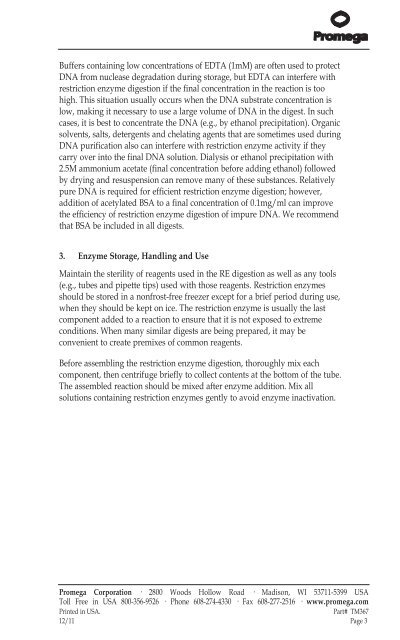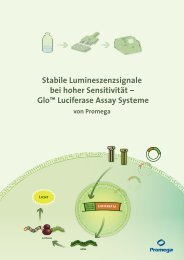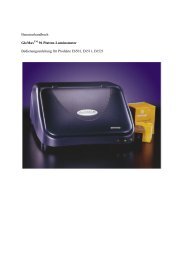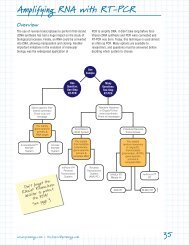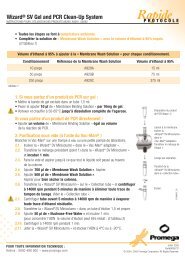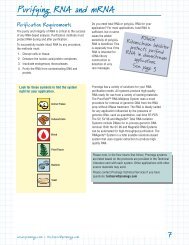Assembly of Restriction Enzyme Digestions - Promega
Assembly of Restriction Enzyme Digestions - Promega
Assembly of Restriction Enzyme Digestions - Promega
You also want an ePaper? Increase the reach of your titles
YUMPU automatically turns print PDFs into web optimized ePapers that Google loves.
Buffers containing low concentrations <strong>of</strong> EDTA (1mM) are <strong>of</strong>ten used to protect<br />
DNA from nuclease degradation during storage, but EDTA can interfere with<br />
restriction enzyme digestion if the final concentration in the reaction is too<br />
high. This situation usually occurs when the DNA substrate concentration is<br />
low, making it necessary to use a large volume <strong>of</strong> DNA in the digest. In such<br />
cases, it is best to concentrate the DNA (e.g., by ethanol precipitation). Organic<br />
solvents, salts, detergents and chelating agents that are sometimes used during<br />
DNA purification also can interfere with restriction enzyme activity if they<br />
carry over into the final DNA solution. Dialysis or ethanol precipitation with<br />
2.5M ammonium acetate (final concentration before adding ethanol) followed<br />
by drying and resuspension can remove many <strong>of</strong> these substances. Relatively<br />
pure DNA is required for efficient restriction enzyme digestion; however,<br />
addition <strong>of</strong> acetylated BSA to a final concentration <strong>of</strong> 0.1mg/ml can improve<br />
the efficiency <strong>of</strong> restriction enzyme digestion <strong>of</strong> impure DNA. We recommend<br />
that BSA be included in all digests.<br />
3. <strong>Enzyme</strong> Storage, Handling and Use<br />
Maintain the sterility <strong>of</strong> reagents used in the RE digestion as well as any tools<br />
(e.g., tubes and pipette tips) used with those reagents. <strong>Restriction</strong> enzymes<br />
should be stored in a nonfrost-free freezer except for a brief period during use,<br />
when they should be kept on ice. The restriction enzyme is usually the last<br />
component added to a reaction to ensure that it is not exposed to extreme<br />
conditions. When many similar digests are being prepared, it may be<br />
convenient to create premixes <strong>of</strong> common reagents.<br />
Before assembling the restriction enzyme digestion, thoroughly mix each<br />
component, then centrifuge briefly to collect contents at the bottom <strong>of</strong> the tube.<br />
The assembled reaction should be mixed after enzyme addition. Mix all<br />
solutions containing restriction enzymes gently to avoid enzyme inactivation.<br />
<strong>Promega</strong> Corporation · 2800 Woods Hollow Road · Madison, WI 53711-5399 USA<br />
Toll Free in USA 800-356-9526 · Phone 608-274-4330 · Fax 608-277-2516 · www.promega.com<br />
Printed in USA. Part# TM367<br />
12/11 Page 3


